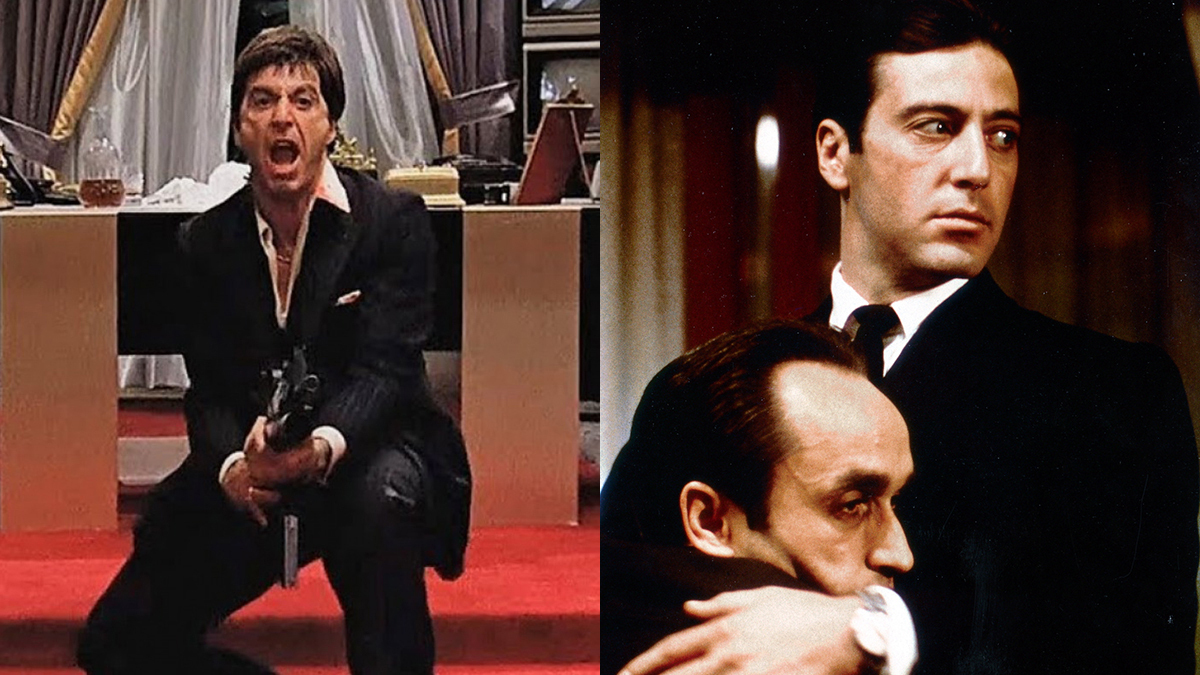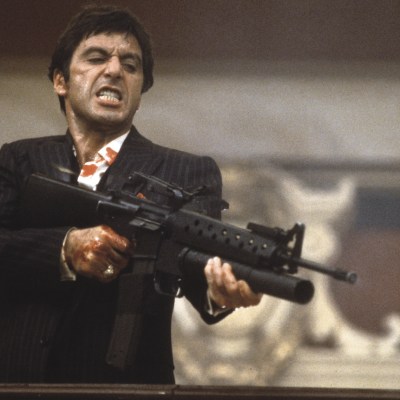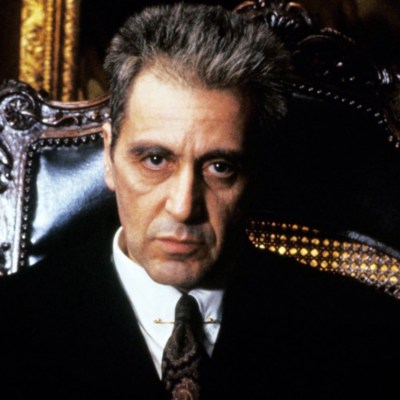Scarface hadn’t been made when Pete Townshend’s 1974 song “The Punk and the Godfather” came out, but The Godfather certainly had. The Who’s anthem was a musical allegory about the rock scene, but the lyrics might as well be interpreted as a conversation between Michael Corleone and Tony Montana. Possibly right before they rumble.
Al Pacino played both men in both movies, and in each film, he begins the story as a punk. But in The Godfather, at least, he grows into the establishment. Michael becomes don. Tony was a shooting star on the other hand, one on a collision course with an unyielding atmosphere. Both roles are smorgasbords of possibilities to an actor, especially one who chased Richard III to every imaginable outcome. Each are also master criminals. But which is more masterful?
The obvious answer would seem to be Michael Corleone because he turned a criminal empire into a multi-billion-dollar international business, and lived to a ripe old age to regret it. Cent’anni, Michael. Tony Montana doesn’t live to see the fruits of his labor, but his career in crime is littered with the successes of excess.
Montana is a hungry, young, loose cannon, just like real-life’s “Crazy” Joe Gallo, who went up against the Profaci family in the street fight which Mario Puzo and Francis Ford Coppola used as inspiration on The Godfather. Gallo stand-in Virgil “The Turk” Sollozzo (Al Lettieri) did a lot of damage while he was trying to muscle in on Don Vito Corleone’s territory, selling white powder. Montana leaves a larger body count in the wake of his cocaine empire career.
Scarface is Pacino’s film. The whole movie is about Tony Montana and his meteoric rise through money, power and women. The Godfather is a mob movie, crowded with top rate talent in an ensemble case, but it belongs to Marlon Brando. While Michael inherits the position by The Godfather, Part II, he shares Godfather roles with Robert De Niro there, and people come away feeling a little sorry for Fredo. Michael isn’t the focus of an entire film until The Godfather, Part III, and by then folks were only distracted by his daughter. Tony Montana owns the screen from the moment it opens until his last splash in the fountain under the “World Is Yours” sign. The picture was his.
Making Your Bones on First Kills
Pacino brings little of the wisdom of his Godfather role to Scarface’s title character. This is by design. Every crime boss has to make his bones. In mafia organizations, real and cinematic, the button men on the street are called soldiers. And every soldier has to go through basic training before they’re ready to earn their button. Michael gets assassination training from his father’s most trusted capo, Pete Clemenza (Richard S. Castellano) before he goes out to enjoy the veal.
Scarface doesn’t give us many details of the crimes Tony was involved in while still in Cuba, so he makes his cinematic bones executing General Emilio Rebenga in the American detention camp for Cuban refugees. The two scenes are polar opposites in all ways but suspense.
When Michael is sitting at the dinner table with Sollozzo and Police Captain McCluskey (Sterling Hayden), he lets Sollozzo do all the talking, easing him into comfort before pulling the trigger. Tony barely lets Rebenga get a whimper in during his first onscreen hit, which plays closer to an execution. Tony covers the sounds of his own attack with a chant he himself begins. It is a brilliant overplay, especially when compared to another scene that resembles The Godfather, with Tony killing a mid-level gangster and a crooked cop towards the end of Scarface.
A major difference between the two roles is best summed up in a line Tony says in Scarface. He learned to speak English by watching James Cagney and Humphrey Bogart. Montana comes from the Cagney tradition of broad gangster characterizations. In The Godfather, Kay Adams (Diane Keaton) asks Michael if he’d prefer Ingrid Bergman. The young soldier has to think about it. This is because Pacino is miles removed here from Bogart, who played Bergman’s lover in Casablanca. Pacino’s two gangster icons approached their criminality differently, and Pacino gets to play in both yards.
Pacino remains on an even keel in the Godfather films, but gives a tour de force of violent expression in Scarface, which burns like white heat.
The Handling of Enemies and Vices
In Scarface, Pacino gets to be almost as over the top as he is in Dick Tracy. His accent would never make it past the modern culture board at The Simpsons, but he pulls it off in 1983 because he says so. Pacino bullies the audience into believing it. It’s that exact arrogance which makes us root for Tony Montana. We don’t want to be on his bad side. But the chilled reptilian stare of Michael Corleone is a visual representation of why Sicilians prefer their revenge served cold.
Michael is diabetic, and is usually seen drinking water in The Godfather films. Sure, he has an occasional glass or red wine, and possibly some Sambuca with his espresso, but Michael always keeps a clear head. Tony, not so much. He makes drunken scenes at his favorite nightclubs, and not only gets high on his own supply, but gets so nose deep in it he develops godlike delusions of superheroic grandeur.
Montana is impulsive, instinctive, and decisive. Tony kills his best friend Manny Ribera (Steven Bauer) immediately upon finding him with his little sister Gina (Mary Elizabeth Mastrantonio). Michael waits until his sister Connie (Talia Shire) is on a plane to Tahoe before he has her husband killed in a hit years in the planning. Later Michael hangs his head silently as the shotgun blast which kills his brother, Fredo (John Cazale), echoes in the distance.
Tony, meanwhile, continues yelling at Sosa’s right-hand man long after his brains are all over the automobile’s interior.
Clothes Make the Man
Tony is written to be charismatic. Even coked out of his mind, he’d be a better fit in Vegas with Fredo’s crowd than with wet blanket Michael in Tahoe. Tony sports white suits, satin shirts, and designer sunglasses. Michael accessorizes three-piece ensembles with an ascot. This isn’t to say Michael had any issues with getting somebody’s brains splattered all over his Ivy League suit.
Designed by Theadora Van Runkle, Michael preferred dupioni silk. That’s smart. The dark navy wool chalk-stripe suit Tony wears in his death scene was designed by Tommy Velasco and carries the class of a tuxedo. It was after 6pm. What do you think he is, a farmer?
“I’m the guy in the sky, flying high, flashing eyes. No surprise I told lies, I’m the punk from the gutter,” Roger Daltrey belts out on “The Punk and The Godfather.” This is exactly against the no-flash advice Frank Lopez (Robert Loggia) tries to impart on his young protégé in Scarface. Tony was raised not to take any advice other than his own. He also ignores his consigliere’s advice on several occasions. When Manny reminds Tony the pair of them were in a cage a year ago, the rebel gangster says he’s trying to forget that, he’s going after the boss’ girl.
“I come from the gutter,” Montana proudly contends. “I know that. I got no education but that’s okay. I know the street, and I’m making all the right connections.”
By contrast, Michael attended Dartmouth College and then dropped out to join the Marines after the attack on Pearl Harbor. Michael is both intelligent and well-connected, loosely modeled on Joseph Bonanno and Vito Genovese. He also accepts the wisdom of his father, who most closely resembled “The Prime Minister” of New York’s Five Families in the 1950s, mafia boss Frank Costello.
The Better Family Man
Pacino’s Don Michael Corleone has access to all his family’s connections, stretching back to the old world. He learns to expertly pull the strings of powerful men, like his father did, but as he grew, he bent. Michael is friends with senators, meets with the President of Cuba, has money in the Vatican, and confesses his sins to a Pope. Michael was insulated throughout his childhood and criminal career. If Tony gets in trouble, he has to get out of it himself, or with the help of a handful of low-level operatives.
Michael is the family rebel, risking his life and getting medals for strangers. He also gets to be both the prodigal son and the dutiful son. He gets the fatted calf and pays the piper. He even tips the baker’s helper for the effort. Michael comes back to both of his families, crime and birth, with a vengeance. He is there for his father the moment he is needed. Michael is the better family man. Tony’s mother is ashamed of him, and he completely ruins his sister’s wedding. Michael’s family means everything to him, and while he still manages to lose them, he actually maneuvers his two families well over rough waters for a very long run.
Tony Montana is the rebel’s rebel. Even before he tosses off his bandana at the dishwasher job to make a quick score, we knew. He was born bad, in the cinematically good way. This also makes Montana a natural at crime. In The Godfather, Michael has it in his blood as a Corleone, but has his heart set on college, a straight career, and a shot to bring his whole family into the American Dream, which for Montana only exists as a wet dream.
Tony never gets past the hormonal teenage phase of his love of America. He wants to love his new country to death. He is turned on by the dream. He wants to take it. Not earn it. No foreplay necessary, as he claims his latest victim’s wife as his own.
Managerial Skills
Michael is pretty good with his underlings, when he’s not having them garroted on the way to an airport or advising them to slit their wrists in a bath. He promises Clemenza he can have his own family once the Corleones relocate to Las Vegas. He lets Joe Zaza (Joe Mantegna) get away with murder as the guy he sets up to run his old territory in The Godfather, Part III. Michael doesn’t keep turncoats like his trusted caporegime Tessio (Abe Vigoda) around for old times’ sake, and he doesn’t suffer fools at all. It may seem he cuts Tom Hayden (Robert Duvall) loose a little fast, and without warning or due cause. But if he was a wartime consigliere, he would have seen it coming.
While Tony Montana may have a competitive and fast-tracked entry program for new workers (“hey, you got a job”), he’s also the guy who shoots his right-hand man Manny for marrying his sister. Tony exacts a brutal and dangerous revenge for the death of his friend Angel Fernandez in the Miami chainsaw massacre, but doesn’t lift a finger when his cohort Omar Suarez (F. Murray Abraham) is hanged to death from a helicopter by drug lord Alejandro Sosa (Paul Shenar). Michael does have a tendency to have his soldato kiss his ring, but he’s not entirely a .95 caliber pezzonovante.
Read more
One of the most important skills a boss must exhibit is how to delegate, and Corleone is a minor Machiavellian master at his delegation. He whispers orders from behind closed doors. Tony is more hands-on. The only reason he tells Manny to “kill that piece of shit” Frank is because he’s already humiliated his former boss into a shell of a real man.
Montana is in the trenches with his soldiers and sets standards by example. He shoots a guy on a crowded Miami street in broad daylight. Montana is a born triggerman and only reluctantly delegates the duty. He has 10 bodyguards when Sosa men raid his mansion fortress. He takes the invading force with one little friend, an M16A1 rifle with a customized grenade launcher. But it sure doesn’t help the employees getting murdered outside.
A Handle on Finances
We don’t know what kinds of criminal activities the Corleone family were involved in between 1958 and 1979. Still, Michael had proven himself a traditionalist and a bit of a prude, so he spends most of his career shaving his take from harmless vices and avoiding drugs, which he sees as a dirty business. But through whatever means, by The Godfather, Part III, Michael has earned enough capital to buy himself out of crime.
Michael gambles successfully on Wall Street, keeps the Genco olive oil company going, and invests in hotels, casinos, and movie studios. He’s got to be pulling in a billion dollars a year in legitimate business. He makes enough to pad the coffers of the Vatican, and his share of Immobiliare stocks pulls in another $1 billion.
Tony looks like he’s earning about $15 million a month. But it doesn’t look like he puts much stock in his future. He makes no investments, only purchases. His only visible holding is the salon his sister works in. But we also have to take into account that he built his empire from scratch. Michael inherited his. And while the head of the Corleone family can blackmail a U.S. senator with a tragic sex scandal, Montana fares no better than Al Capone with tax evasion.
Who Would Win in a Mob War?
Scarface is as violent as the 1932 Howard Hawk original. Blood is a big expense, and 42 people are killed in the 1985 film. It came out amid other over-the-top action blockbusters like First Blood and the contemporary reality of the South American drug trade. So, it would seem, the film has far more violence. But they are easily matched.
The Godfather has a horse’s head, Scarface has a chainsaw. Michael’s brother Sonny (James Caan) gets machine gunned to smithereens at the toll booth, Tony blows the lower limbs off his would-be assassins at a nightclub. Omar is lynched in a chopper, the upper echelon of the mob is taken out by helicopter fire in The Godfather, Part III. Tony and Michael each get to kill a cop.
Both mob figures survive assassination attempts. Michael loses his wife Apollonia in Sicily in a car bombing meant for him. He also avoids the trap Tessio sets at the meeting with Emilio Barzini (Richard Conte), on his turf, where Michael “will be safe.” Tony lives through his initial professionally ordered hit, as well as being saved by Manny from certain death by chainsaw.
While Michael Corleone is able to take care of Barzini, Victor Stracci, Carmine Cuneo, and Phillip Tattaglia – the leadership of the five families – at the end of The Godfather, Tony Montana can only put up a good fight. The Corleone family would win in a protracted war against Montana’s cartel, but there is a possibility Tony would have outlived Michael while the battles raged. Expert swordsmen aren’t afraid to duel the best in the field, but they’re scared of the worst.
As far as crime tactics and strategic villainy, Michael Corleone plays a game of chess. Tony Montana plays hopscotch. He wins by skipping cracks in the street, but he only rises as far as the pavement.


